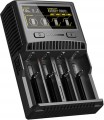Operation indicator
The method of indicating work, in other words, the type of notifications provided for in the design of the charger.
— LED. LED indicators can give messages by turning on and off, blinking at a certain frequency, and changing colours. They are cheaper than displays (see below) and are more visible from a distance, but less informative and more limited in their capabilities.
—
Display. Chargers tend to use simple LCD displays. However, even such screens are much more informative and visual than LED indicators. A wide variety of information can be displayed on the display, and in a form that is convenient for perception: the user does not need to remember what this or that light means, he immediately sees a specific message, for example, “Charging is over”. However and this convenience is much more expensive.
Independent charge channels
The number of independent charging channels provided in the design of the charger.
If the voltage, charging current and other parameters in this model are regulated on all battery slots at the same time, this means that the device has only one channel. The presence of several charging channels allows you to set your own operating parameters on separate slots and, accordingly, simultaneously charge different types of batteries in one device. In this case, the channel can cover both one slot and several: for example, many models for 4 batteries have only 2 channels (one for every 2 slots).
The abundance of channels expands the capabilities of the "charger" and will be especially useful in cases where you often have to charge different types of batteries; on the other hand, it significantly affects the cost of the device.
Min. charge current
The smallest current that the device can provide in charge mode. If this parameter is specified in the specifications, this means that this model has the ability to adjust the charge current (otherwise, only the maximum current is indicated).
Charging current is one of the most important parameters for any charger: see “Maximum charge current. And the general range of current adjustment depends on this indicator: the lower the minimum value (with the same maximum) — the more extensive the possibilities for setting up the "charger" for the specific specifics of work.
Max. charge current
The highest current that the device can provide when charging the battery (or the nominal value of the charging current, if it is not adjustable).
Charging current is one of the most important parameters for any charger: it determines the speed of the process and compatibility with certain batteries. In general, the higher the current, the faster the process, the less time it takes to charge. At the same time, some batteries may have recommendations for the optimal current strength and restrictions on its maximum values. Therefore, mindlessly chasing a powerful charger is not worth it: at first it's ok to clarify how justified such power will be.
Note that in multi-channel devices (see "Independent channels"), the maximum current strength can be achieved when only part of the channels are operating. The indicators provided when all channels are operating simultaneously are indicated separately for such models (see "Charge current (all channels)").
Charge current (all channels)
The highest current provided by a multi-channel charger (see "Independent channels") at full load, with all slots (and, accordingly, channels) operating. In fact, a guaranteed maximum current provided by a multi-channel charger, regardless of the number of channels involved.
For the total charge current, see “Maximum charge current. Here we note that the full load is a rather complex mode in which the current strength can decrease. Therefore, this parameter is specified separately.
Preliminary discharge
Pre-discharge is useful for batteries that are prone to memory effect - they need to be charged only after the charge is completely depleted. In accordance with the name, a charger with this function is capable, if necessary, of discharging the installed battery “to zero” before starting charging. At the same time, some models are able to automatically detect the presence of residual energy and turn on a preliminary discharge, in others it must be turned on manually.
Fault detection
A diagnostic system capable of detecting faulty batteries, disconnecting them from power and notifying the user. The
fault detection function is useful not only for checking the performance as such: a battery malfunction that is not detected in time is fraught with equipment damage, and in some cases even fires.
USB output charging gadgets
The ability to use the charger to charge portable electronics - smartphones, tablets, players, etc. As a rule, for this, a
USB port is provided in the design, for connection to which an appropriate cable is required; in fact, you can charge from such a device not only mobile gadgets, but also any equipment that can be powered from USB. True, it is worth noting that some manufacturers do not recommend using third-party devices for their equipment if they are not officially approved.
Short circuit protection
Short circuit protection function . Such a short circuit can occur both during charging (for example, due to a malfunction of the connected battery or a foreign object getting between the contacts), and during discharging (due to a failure already in the memory itself). In any case, a short circuit leads to a sharp increase in current strength and abnormal loads on equipment, the consequences of which can be breakdowns and fires. To avoid this, short circuit protection is used - usually in the form of a fuse that turns off the power when the current increases sharply. Note that such a fuse can be both reusable and disposable, requiring replacement after operation.

